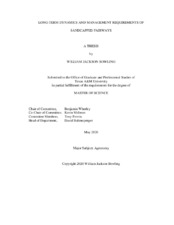| dc.description.abstract | As golf course irrigation water quality continues to decline, sand-capping of golf course fairways is increasing. Capping of degraded golf course fairways with a layer of sand to promote better turfgrass health, performance, and playability is becoming a common practice where irrigation water is of poor quality, usually high in sodium. Benefits of sand-capping include improved surface drainage and increased infiltration rates, greater rooting depth, improved traffic tolerance and playing conditions, alleviated compaction, enhanced ability to flush salts from the upper root zone, and improved soil structure (White, 2013). However, over time, unique management challenges may arise, including organic matter accumulation, surface hydrophobicity, and subsoil permeability issues, especially where irrigation water contains elevated levels of sodium. Our results indicate that capping depth plays a critical role in turfgrass quality, volumetric water content, sorptivity, percent green cover, sodium adsorption ratio, hydrophobicity of the surface, organic matter content, and thatch depth with the shallower capping depths often outperforming the deeper capping depths.
Our results indicate that gypsum applications are affective at reducing sodium adsorption ratio (SAR) in sand-capped systems and that while wetting agent applications are important, they may only be necessary in deeper capping systems. Our results indicate that the more aggressive cultural practices lead to a short-term reduction in turfgrass quality but provide a greater turfgrass quality later into the season. Our results suggest that moisture is potentially a key factor in how these capping depths perform regarding the parameters measured. The research-based information learned from this study will help turfgrass professionals best manage their sand-cap systems in the future and will be utilized when constructing future/renovating established turfgrass systems. | en |


